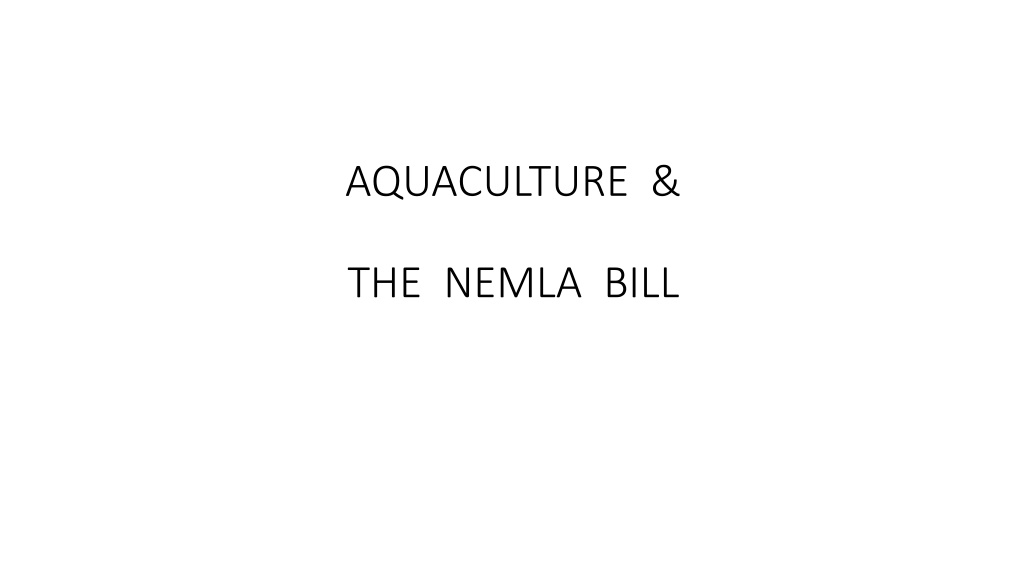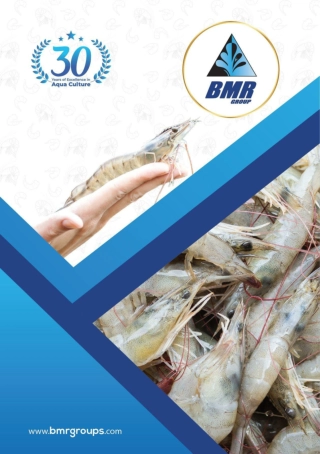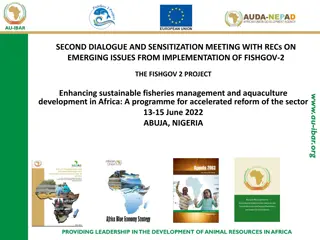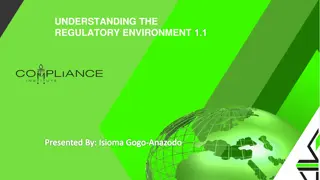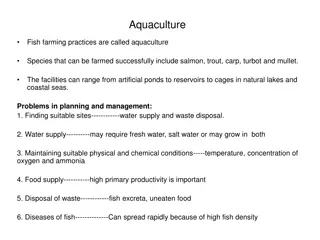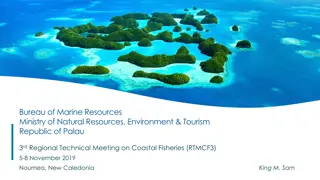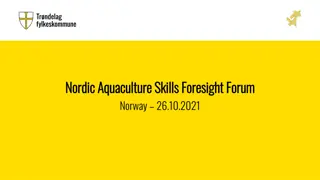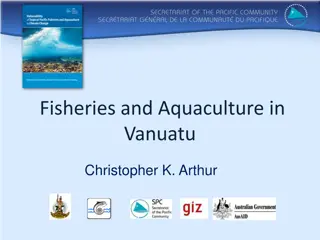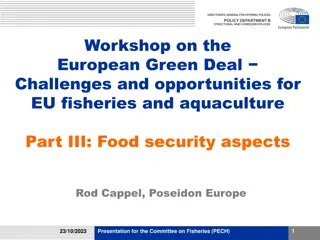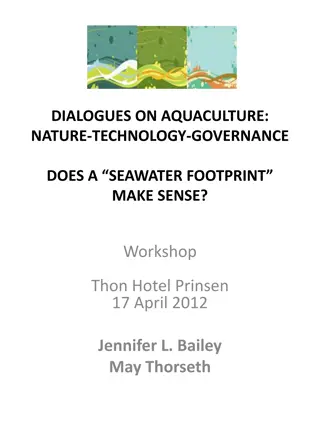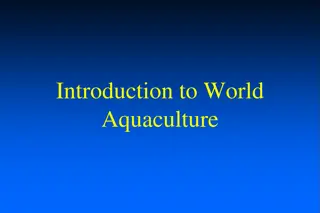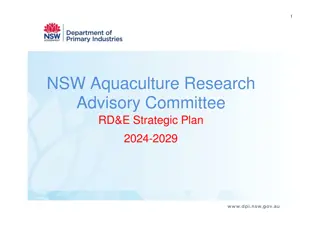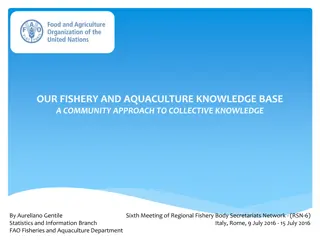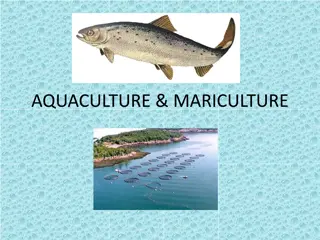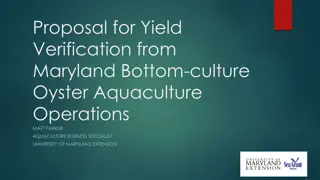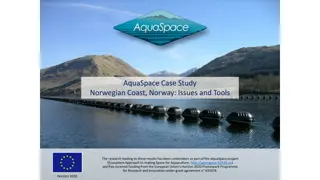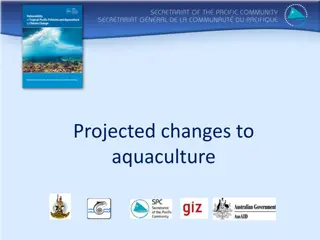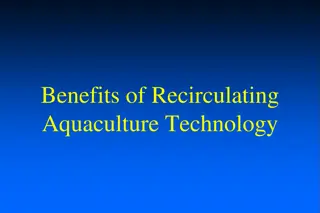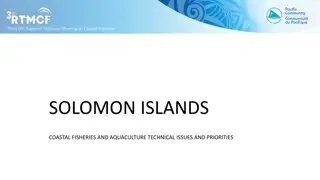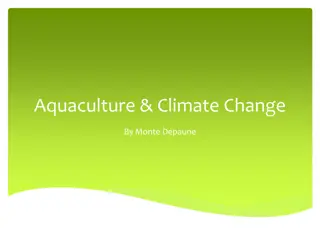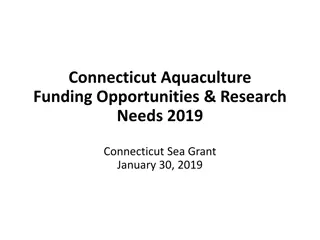Understanding Aquaculture and Its Regulatory Impacts on Industry Growth
Aquaculture involves farming fish, molluscs, and plants in controlled environments, offering a sustainable way to grow economies and provide protein. However, regulatory efforts like NEMBA are affecting industry growth by imposing restrictions on both alien and indigenous species. These regulations pose challenges to the aquaculture value chain, hindering growth and creating obstacles for new entrants.
Download Presentation

Please find below an Image/Link to download the presentation.
The content on the website is provided AS IS for your information and personal use only. It may not be sold, licensed, or shared on other websites without obtaining consent from the author. Download presentation by click this link. If you encounter any issues during the download, it is possible that the publisher has removed the file from their server.
E N D
Presentation Transcript
AQUACULTURE & THE NEMLA BILL
THE REGULATION OF AQUACULTURE AQUACULTURE Is the farming of fish, molluscs and plants in both fresh and seawater . It is not like the fishing industry which harvests a natural resource. It is a farming activity no different to any other. Done responsibly aquaculture offers a sustainable environmentally safe way of: growing rural economies and employment Providing an additional source of protein for SA s rapidly growing population.
AQUACULTURE AND NEMBA NEMLA impacts on aquaculture in that DEA is trying to use NEMBA to restrict the growth of aquaculture through regulation either because: The aquaculture species is alien and which means that according to DEA it must be regulated as invasive . The aquaculture species is indigenous and thus must regulated as if it is wild and in ways which confine that species to what DEA believe to be its historic natural distribution range.
AQUACULTURE AND NEMBA Both initiatives are unrealistic because: In the case of invasive species DEA s approach ignores current realities and the benefits that flow from utilising these species In the case of indigenous species DEA s backward looking NDR s are incompatible with the present day situation and the fact of a rapidly changing environment.
IMPACTS ON AQUACULTURE VALUE CHAIN PHAKISA RED TAPE REDUCTION The various Phakisa Labs recommended rationalisation and harmonisation of laws to create an enabling environment for the growth of these sectors. The reality experienced by value chain members is contra to these expectations with a drastic increase in compliance costs and extended time frames. The changes proposed by NEMLA with increased discretionary powers, added policy uncertainty, and arbitrary decision making result in increased business risk, operational difficulties and a total failure to create an enabling environment. All of this acts as an impediment to new entrants
Forecast growth in ZAR (Million) over next 10 years if if Phakisa is effective Growth in Value - Millions 3,000 2,500 2,000 1,500 1,000 500 0 Abalone Trout Mussels Oysters TOTAL 2018 2028
Forecast growth in production (Tons) in next 10 years - if if Phakisa is effective Growth in Tons 18,000 16,000 14,000 12,000 10,000 8,000 6,000 4,000 2,000 0 Abalone Trout Mussels Oysters TOTAL TONS 2018 TONS 2028
Biocentric values underlining NEMLA changes to NEMBA is not congruent with a successful Phakisa outcome.
Trout Industry - Key Facts Trout Value Chain - processing, retail and export of trout & trout products, ca R1.2 billion - associated leisure, guiding and tackle industry ca R1.8 billion - Trout based, embedded investment (villages, lodges, hotels, restaurants, angling syndicates) > R7.5billion Aquaculture production 1700 mt table trout pa. 200 mt live trout for stocking of angling facilities 90 million fertilised trout ova for export 800 000 trout fingerlings for on-growing and restocking farm gate value between R300 & R400 million.
THE TROUT VALUE CHAIN Work opportunities - about 13 000 people employed in the trout value chain - small towns like Dullstroom, Rhodes, Underberg and Hogsback >80% of employment, is trout based - Mpumalanga trout triangle, KZN Midlands & Drakensberg, E & W Cape, E Free State, Gauteng and Haenertsburg in Limpopo, have unrealised trout-based tourism potential - Trout production potential in these areas under-utilised - Economic growth and employment potential in these rural areas constrained by overregulation
MARINE AQUACULTURE VALUE CHAIN ABALONE: Farm production: 1 500 mt pa. Live, canned, dried and frozen Export earnings: R800m pa Employing: 2500 coastal community members Value Chain: Processing and export of abalone, ca R500m Maintenance and safety: R50m
MARINE AQUACULTURE VALUE CHAIN OYSTERS AND MUSSELS: Farm production: Oysters: 700 mt pa Earnings: R40m pa Mussels: 3 000mt pa Mussels: R72m pa Value Chain: Employment: 500 coastal community members Processing, retail and export of oysters and mussels: ca R10m Maintenance: R5m pa AquacultureSA
TILAPIA BASED AQUACULTURE Nile tilapia (NT) the only viable tilapia culture species . But the NT is listed as invasive because it breeds with the indigenous Mossambicus tilapia. Farming Nile tilapia as a category 2 invasive species is not economically viable because adverse regulatory requirements applicable to invasive species. Farming Mossambicus tilapia is not economically feasible.
TILAPIA BASED AQUACULTURE : NEEDS Clear Policy that reconciles the conflict between DAFF s desire to grow tilapia production with DEA s desire to control Nile Tilapia as an invasive species. As a priority the introduction of: A zonal system where fish sanctuaries are created to protect Mossambicus Tilapia The identification of areas where Nile Tilapia and hybrids already occur and where Nile Tilapia should not therefore be listed as invasive
AQUACULTURE NEEDS AQUACULTURE NEEDS A biodiversity policy developed in terms of a lawful, and inclusive, process that engages Aquaculture and other Stakeholders A people-first outcome that conserves biodiversity whilst promoting sustainable development. Reasonable and enabling laws that are congruent with policy
CONCLUSION We respectfully request that: proposed NEMA sections 31 J and K amendments to be abandoned or referred back to DEA to be redrafted ; proposed amendments to NEMBA be postponed pending the completion of a proper policy development process; the 2015 NEMLA Bill be postponed pending proper compliance with the SEIAS guidelines; and thereafter, the NEMLA Bill be subjected to a new and compliant public consultation process.
